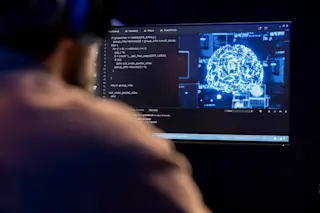If you remember your high school biology course, you may recall some primitive pictures of DNA—illustrations of the double-helix that looked like a twisted, primary-colored ladder of kiddie blocks. Thankfully, there are artists out there talented enough to translate the mind-numbing language of science into content that is accurate and, perhaps more important, sexy. Science recently awarded savvy artists for their efforts via the 2006 Science and Engineering Visualization Challenge.
Having a soft spot for biology, I thought the most stunning of the entries was the University of Melbourne's “Body Code” by Drew Berry: a 9-minute tour of a freakishly chaotic molecular world (warning: a 35MB clip lays in wait).
In the first part of the film, we’re taken to the surface of a stem cell. Like a spasming blue seahorse, a surface antenna protein wiggles on screen and waits for its chemical cue. When it receives the signal—a flying, glowing, orange-yellow ball of fire straight out of Super Mario Brothers—it changes shape, pairs with another activated protein buddy, sends out a signal to the immune system, and ultimately instructs the stem cell to divide.
Next up is DNA organization. A pinkish double-helix strand appears on-screen, quivering like the tail of an angry rattlesnake. Then a histone protein, looking like a frantic blue puppy, comes seemingly out of nowhere lands on the piece of DNA. Two more upset puppies land on the snake and begin curling it into a chromosome. While Science just wets our appetites with a 1 minute and 32-second clip, the snippet alone is enough to reveal the molecular world as dynamic and energetic.
Instead of hashing out crude drawings on the chalkboard, instructors should start lessons with animations like these. Even if students don’t yet understand what they’re looking at, it’s much more engaging to watch frenzied puppies landing on rattlesnake tails. Animations might better inspire students to learn how DNA works, perhaps using simpler diagrams like a ladder of multi-colored kiddie blocks.
(To see more of Berry's films, click here.)













